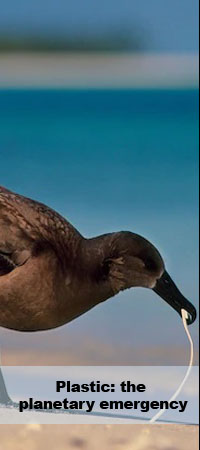|
The majority of consumer products used today are comprised of some form of plastic. Worldwide, almost 280 million tons of plastic materials are produced annually, much of which ends up in landfills or the ocean. While plastics are lightweight, inexpensive, and durable, these same qualities can make them very harmful to wildlife, especially once they become waterborne. Once seaborne, plastics are most likely found circulating in one of five major ocean gyres: two in the Pacific, one in the Indian, and two in the Atlantic. These ocean garbage patches are not solid islands of plastic; instead, they are a turbid mix of plastics.
Invasion of plastics in different ecosystems is causing severe problems to inhabitants. Wild animals such as seabirds, fishes, crustaceans, and other invertebrates are mostly affected by plastic entanglements and organic pollutants absorbed and carried by plastics/microplastics. Plastics can also be potentially harmful to human beings and other mammals.
Plastic pollution is now pervasive in the Arctic, even in areas with no apparent human activity, such as the deep seafloor. The sheer extent of plastic pollution is astounding. Like the impacts of climate change or habitat loss and damages, there is no ecosystem on Earth untouched by plastics. Research has found plastics in the Mariana Trench, Mount Everest, the Pyrenees Mountains, remote oceanic islands, polar ice sheets, lungs and placenta of humans, feces of infants, the food we eat (e.g., cheese, beer and salt), the air we all breathe, and the water we all drink. Finally, coral reefs around the world are impacted by microplastics at an unprecedented scale by increasing the likelihood of disease in corals.
Endangered Species International (ESI) is calling the plastic pollution a planetary emergency in the same level as climate change and species extinction. ESI is calling all governments to ban most plastics and reduce their use.
7 simple things you can do to help reduce plastic pollution and clean-up ocean:
Don’t use plastic bags. Use a reusable bag or bag made of nature materials;
Reduce your use of plastics, reuse plastic products whenever possible, recycle all you can as last resort
Look for less packaging or no plastic packaging. If products come with too much packaging, refuse to buy them and complain to the manufacturers by sending emails or phone calls;
Watch out and avoid for toiletries that contain microbeads. These small plastic beads are found in some facial products, soaps, shower gels and toothpastes. They are very small so can't be effectively filtered from waste before it enters rivers, lakes or oceans;
Pick up litter next time you are in nature (e.g., beach, forest);
Support local and national legislations that ban the use of plastics;
Support ESI aggressive program to remove plastics from ocean.
Related Links
|











